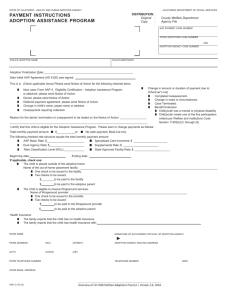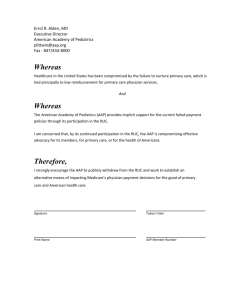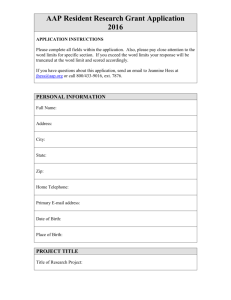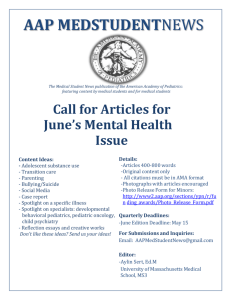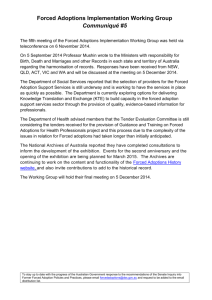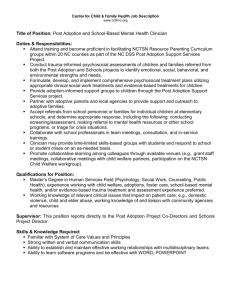DSS Policy and Procedure Guide
advertisement
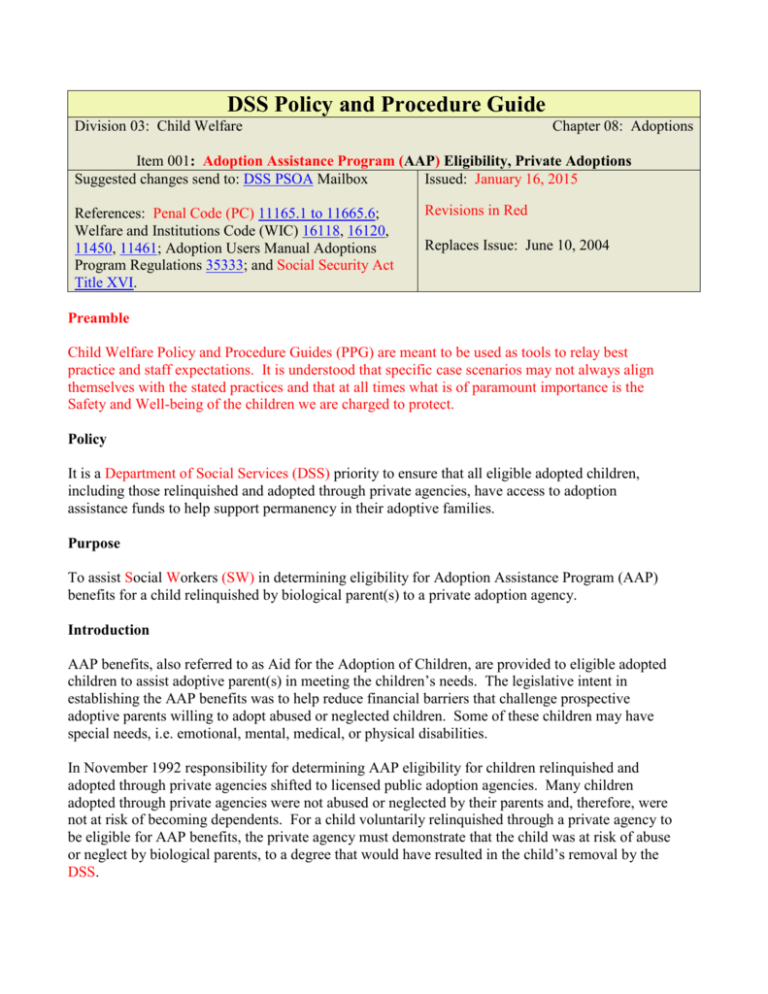
DSS Policy and Procedure Guide Division 03: Child Welfare Chapter 08: Adoptions Item 001: Adoption Assistance Program (AAP) Eligibility, Private Adoptions Suggested changes send to: DSS PSOA Mailbox Issued: January 16, 2015 References: Penal Code (PC) 11165.1 to 11665.6; Welfare and Institutions Code (WIC) 16118, 16120, 11450, 11461; Adoption Users Manual Adoptions Program Regulations 35333; and Social Security Act Title XVI. Revisions in Red Replaces Issue: June 10, 2004 Preamble Child Welfare Policy and Procedure Guides (PPG) are meant to be used as tools to relay best practice and staff expectations. It is understood that specific case scenarios may not always align themselves with the stated practices and that at all times what is of paramount importance is the Safety and Well-being of the children we are charged to protect. Policy It is a Department of Social Services (DSS) priority to ensure that all eligible adopted children, including those relinquished and adopted through private agencies, have access to adoption assistance funds to help support permanency in their adoptive families. Purpose To assist Social Workers (SW) in determining eligibility for Adoption Assistance Program (AAP) benefits for a child relinquished by biological parent(s) to a private adoption agency. Introduction AAP benefits, also referred to as Aid for the Adoption of Children, are provided to eligible adopted children to assist adoptive parent(s) in meeting the children’s needs. The legislative intent in establishing the AAP benefits was to help reduce financial barriers that challenge prospective adoptive parents willing to adopt abused or neglected children. Some of these children may have special needs, i.e. emotional, mental, medical, or physical disabilities. In November 1992 responsibility for determining AAP eligibility for children relinquished and adopted through private agencies shifted to licensed public adoption agencies. Many children adopted through private agencies were not abused or neglected by their parents and, therefore, were not at risk of becoming dependents. For a child voluntarily relinquished through a private agency to be eligible for AAP benefits, the private agency must demonstrate that the child was at risk of abuse or neglect by biological parents, to a degree that would have resulted in the child’s removal by the DSS. PPG 03-08-001 The criteria for determining if the child is at risk of being removed from their parent(s) are set forth in Penal Code (PC) 11165.1 to 11165.6. Procedure Referral Form The private adoption agency will review the case to determine the child’s potential AAP eligibility. If the agency finds that the child may be eligible, a referral will be made to the Fresno County Adoptions division prior to finalization of the adoption and within 10 calendar days of the signing of the relinquishment. Fresno County Adoptions will respond in writing to the request for AAP benefits after the request is reviewed by the AAP Eligibility Determination Committee. The committee meets once a month to review requests. Once the request is reviewed DSS will send out a written determination within 15 calendar days of the review date. Fresno County Adoptions will determine the county responsible for administration of requested AAP benefits. According to WIC 16118 (e): “For purposes of this chapter, the county responsible for determining the child’s Adoption Assistance Program eligibility status and for providing financial aid in the amount determined in Sections 16120 and 16120.1 shall be the county that, at the time of the adoptive placement, would otherwise have been responsible for making a payment pursuant to Section 11450 under the CalWORKs program or Section11461 under the Aid to Families with Dependent ChildrenFoster Care program if the child were not adopted. When the child has been voluntarily relinquished for adoption prior to a determination of eligibility for such a payment, the responsible county shall be the county in which the relinquishing parent resides. The responsible county for all other eligible children shall be the county where the child is physically residing prior to placement with the adoptive family. The responsible county shall certify eligibility on a form prescribed by the department.” The private agency shall show proof of the relinquishing parent’s county of residence. This proof shall be a driver’s license or identification card, and a current rent, water, or utility receipt. Determination of AAP Eligibility For a child to be eligible for AAP payments, the two following conditions must be met: Under WIC 16120, benefits payment, a child shall be eligible for AAP benefits if all of the conditions specified in subdivision (a) through (l) are met or if the conditions specified in subdivision (m) are met. These conditions, in part, include membership in a sibling group that should remain intact; or by virtue of race, ethnicity, color, or language; age three years or older or adverse parental background; and Page 2 of 4 PPG 03-08-001 Pursuant to WIC 16120 (i) (2) that states: “Relinquished for adoption to a licensed California private or another public agency operating a Title IV-E program on behalf of the state, and would have otherwise been at risk of dependency as certified by the responsible public child welfare agency.” If the above conditions are met, the need for adoption subsidy must be evidenced by the private agency’s unsuccessful search for an adoptive home to take the child without financial assistance, as documented in the case file of the prospective adoptive child. The requirement for this search shall be waived when it would be against the best interest of the child because of the existence of significant emotional ties with prospective adoptive parents while in the care of these persons as a foster child. In the instance of an unsuccessful search to locate a home that is willing to adopt a child without financial assistance, the agency’s documentation shall include: Written description of agency efforts to find a home that would be willing to adopt the child without financial assistance, and Private agency’s contacts with other adoption agencies to determine available families who would be willing to accept the child without financial assistance. There is one exception to the preceding criteria. A child who is relinquished for adoption to a licensed California private or public adoption agency, or to the California Department of Social Services (CDSS), or who is adopted through the independent adoption process is eligible for AAP benefits, if, at the time the adoption petition is filed: The child meets the requirements for Title XVI SSI benefits as determined by a designated SSA claims representative; Appropriate documentation of the child’s SSI eligibility is provided to the adoption agency; and The child has been determined to be AAP eligible in accordance with the other provisions of WIC 16120. Public Adoption Agency (DSS) Responsibility A private agency cannot make its own final determination of eligibility. The DSS would not incur liability or responsibility for agreements not processed as outlined in this PPG. Designated Fresno County Adoption staff will receive, review and assess referrals to determine eligibility, as follows: Receive, review and assess referral o Determine if there is Child Protective Services history in relation to this child or other siblings. o Determine if the child was or is at risk of abuse or neglect by biological parents to the degree that the child would be removed by DSS (PC 11165.1 to 11165.6). Page 3 of 4 PPG 03-08-001 o Convene a review committee. o The committee reviews private agency packet and makes a determination of child’s eligibility for AAP benefits. o Send written eligibility decision to the private agency. Establishment and administration of the AAP program o Pursuant to WIC 16118 (c), the county responsible for providing financial aid in the amount determined in Section 16120, shall have responsibility for certifying that the child meets the eligibility criteria. DSS or the responsible county determines the amount of financial assistance needed by the child and adopting family. o Pursuant to Adoptions Users Manual, Adoptions Program Regulations 35333, and WIC 16119, the responsible public agency shall negotiate the amount and duration of any AAP payment with the family. The negotiation shall be based on the documented needs of the child and the circumstances of the family. Private Agencies Making Their Own Determinations A private agency does not have the authority to make its own determination of eligibility. The DSS would not incur liability or responsibility for any agreements not processed through the proper protocol/procedures as outlined in this PPG. Page 4 of 4
